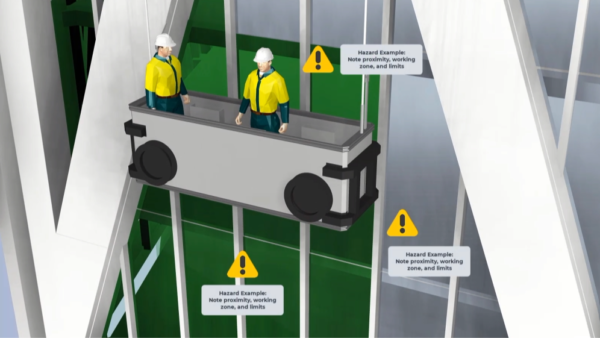
Successful implementation of innovative safety technology requires a proactive mindset, wide engagement with staff and a flexible approach.
Those are three of the seven steps, according to a new report from the Safetytech Accelerator that addresses safety technology implementation. Safetytech Accelerator is an advisory service that brings together safety technology startups and potential customers. Lloyd’s Register established the business in 2018.
The new report, Delivering Safety Innovation, proposes the following seven steps.
Approach change proactively
“Proactive adoption is a strategic advantage and a critical imperative to mitigate risks and ensure compliance, better safety and OSH performance,” the report states.
Proactive triggers include visionary leadership, improvement programmes aimed at reducing incident rates, and the exploration of new technological possibilities.
The Safetytech Accelerator notes that reactive triggers usually emerge from external pressures or critical incidents. While reactive triggers prompt necessary action, “they can result in rushed implementations that fail to integrate into the organisational culture or processes and greater risk of regulatory consequences”.
Get frontline staff insight
“Securing insight from operational staff and safety specialists who work directly with safety challenges helps ensure that the right problems are addressed and potential solutions are practical, relevant, and effective,” the report says.
Doing this also helps to ensure that an organisation already has their buy-in when the time comes for implementation.
Plan and prioritise initiatives
“Failing to plan and prioritise properly makes it more likely that time, money and effort are diverted away from the problems where the biggest safety and business benefits can be achieved,” says the report. “It also risks adopting solutions that will drive limited impact and technologies that may be too costly or could even quickly become outdated.”
Thus, the Safetytech Accelerator proposes the development of a roadmap that requires a thorough assessment of current safety challenges, identifying the most critical areas for improvement, and creating a plan that outlines the actions, timelines, and necessary interventions to address high-priority safety issues.
Build a business case
To fully assess the value that innovative safety technology can bring to an organisation, it is essential to consider the broader business benefits, according to the Safetytech Accelerator.
“While safety professionals focus rightly on saving lives and reducing injuries, convincing colleagues to dedicate time and resources to improve safety outcomes often requires demonstrating how innovation can drive comprehensive business value. Making a business case for safety technology involves highlighting these wider benefits to present a more compelling argument for investment.”
Target the transformational potential
When building a business case for adopting innovative safety technology, it is essential to acknowledge that it may not be business as usual for an organisation but a genuine innovation effort with the potential for transformational improvements.
This level of innovation carries higher implementation and adoption risks that must be managed through the execution process, but it also offers significant rewards if executed correctly. The case for innovation should be bold and seek to achieve a step-change in human and business value.
Identify the right approach
Organisations have a range of innovation implementation routes open to them. The choice depends on several factors, including the desired speed, ambition level, budget constraints, and internal capacity. The approaches range from procuring off-the-shelf solutions to investing in promising technology companies and co-creating solutions. Each strategy involves different levels of internal focus, resource allocation, and varying degrees of external partnership.
Embrace agility and adaptability
“While it is important to be bold and aim for transformative improvements, organisations should start small and iterate,” the Safetytech Accelerator says. It acknowledges that implementing emerging technologies is a challenging endeavour with many unforeseen issues and barriers.
Organisations can minimise costs and increase the likelihood of success in the implementation stage by following a modern agile approach that breaks the project into phases and involves continuous collaboration and refinement. This phased approach allows organisations to focus on the details at each stage in the process without losing the big picture.
Organisations should start with low-cost feasibility studies (possibly with multiple suppliers in tandem) or with low-cost pilot projects to test technologies and demonstrate value in a real-world setting.
Don’t miss out on BIM and digital construction news: sign up to receive the BIMplus newsletter.












